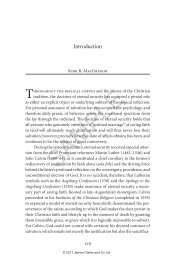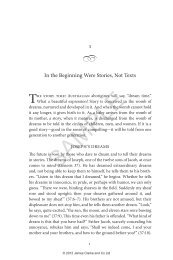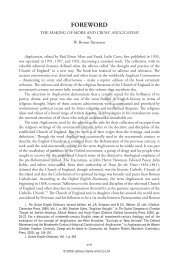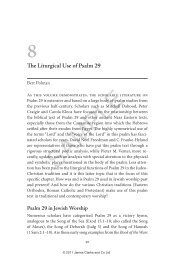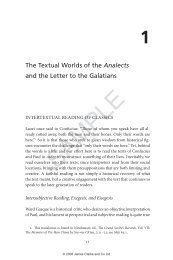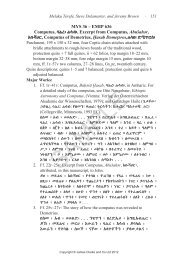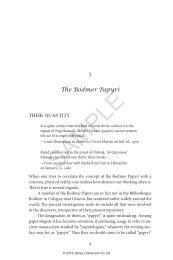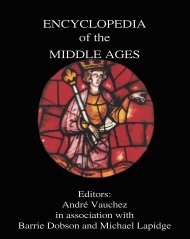Augustine's Conception of Deification, Revisited - James Clarke and ...
Augustine's Conception of Deification, Revisited - James Clarke and ...
Augustine's Conception of Deification, Revisited - James Clarke and ...
Create successful ePaper yourself
Turn your PDF publications into a flip-book with our unique Google optimized e-Paper software.
Augustine’s <strong>Conception</strong> <strong>of</strong> <strong>Deification</strong>, <strong>Revisited</strong><br />
the inherent dignity <strong>of</strong> persons created in the image <strong>of</strong> God, Augustine<br />
echoes some <strong>of</strong> the concerns <strong>of</strong> The Trinity, which he had begun in 400<br />
<strong>and</strong> would not complete until 416, thus placing Dolbeau 6 (dated to 404)<br />
in the midst <strong>of</strong> his meditations on the three Persons <strong>of</strong> the Godhead. In<br />
The Trinity, he implores his reader: “With the example <strong>of</strong> the Image [Christ]<br />
before us, let us also not depart from God. For we are, likewise, the image<br />
<strong>of</strong> God, not indeed an equal image, since it was made by the Father through<br />
the Son, not born <strong>of</strong> the Father as that is” (VII.3.5). 18 (Hence Augustine’s<br />
distinction in Dolbeau 6 that one is made a “son <strong>of</strong> God” not in substance<br />
or by nature, but rather by grace.) The human person is an image <strong>of</strong> the<br />
Image, <strong>and</strong> is called to imitate the Image by “striving.” Further, he writes,<br />
“For the true honor <strong>of</strong> man is to be the image <strong>and</strong> the likeness <strong>of</strong> God<br />
which is preserved only in relation to Him by whom it is impressed”<br />
(XII.11.16). Contrariwise, man’s “likeness to the beasts is his disgrace”<br />
(XII.11.16). The best possession <strong>of</strong> the immortal soul is the “image <strong>of</strong><br />
God its Creator,” something that will not cease to be (XIV.2.4). We look<br />
into a mirror to see an image, he writes, <strong>and</strong> by looking through our own<br />
image we may catch a glimpse <strong>of</strong> “Him by whom we have been made.”<br />
Augustine cites 2 Cor 3.18: “But we, with face unveiled, beholding the<br />
glory <strong>of</strong> God, are transformed into the same image . . . ” Human persons,<br />
as the imago Dei, share in God’s glory (XV. 8.14). Being the image <strong>of</strong> the<br />
blessed Trinity, human persons are endowed with memory, underst<strong>and</strong>ing,<br />
<strong>and</strong> will, which are themselves intended for remembering, seeing, <strong>and</strong><br />
loving God (XV.20.39). In Dolbeau 6, Augustine is especially keen on<br />
insisting that the sacred image <strong>of</strong> God within the human person not be<br />
defiled by the worship <strong>of</strong> corrupt idols. That which is worshipped ought<br />
to glorify <strong>and</strong> not debase the image <strong>of</strong> God within. The intimate<br />
relationship between worship <strong>and</strong> theological anthropology seems never<br />
far from Augustine’s mind, as he implores his audience to remember their<br />
created dignity.<br />
Many <strong>of</strong> the above theological ruminations were made audible in the<br />
living church addressed by Augustine in 404. The concerns voiced in<br />
Dolbeau 6 fit a particular historical context; they reveal Augustine engaged<br />
in battle, yet again. As Peter Brown has remarked, in a new addition to his<br />
SAMPLE<br />
18<br />
The Trinity, tr. Stephen McKenna, C.S.S.R. (Washington: Catholic University <strong>of</strong><br />
America Press, 1963).<br />
129<br />
© 2010 <strong>James</strong> <strong>Clarke</strong> <strong>and</strong> Co Ltd





